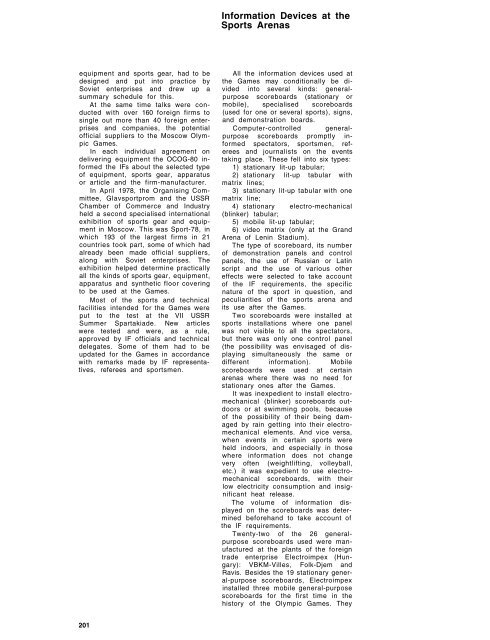or1980v2pt1
or1980v2pt1
or1980v2pt1
Create successful ePaper yourself
Turn your PDF publications into a flip-book with our unique Google optimized e-Paper software.
equipment and sports gear, had to be<br />
designed and put into practice by<br />
Soviet enterprises and drew up a<br />
summary schedule for this.<br />
At the same time talks were conducted<br />
with over 160 foreign firms to<br />
single out more than 40 foreign enterprises<br />
and companies, the potential<br />
official suppliers to the Moscow Olympic<br />
Games.<br />
In each individual agreement on<br />
delivering equipment the OCOG-80 informed<br />
the IFs about the selected type<br />
of equipment, sports gear, apparatus<br />
or article and the firm-manufacturer.<br />
In April 1978, the Organising Committee,<br />
Glavsportprom and the USSR<br />
Chamber of Commerce and Industry<br />
held a second specialised international<br />
exhibition of sports gear and equipment<br />
in Moscow. This was Sport-78, in<br />
which 193 of the largest firms in 21<br />
countries took part, some of which had<br />
already been made official suppliers,<br />
along with Soviet enterprises. The<br />
exhibition helped determine practically<br />
all the kinds of sports gear, equipment,<br />
apparatus and synthetic floor covering<br />
to be used at the Games.<br />
Most of the sports and technical<br />
facilities intended for the Games were<br />
put to the test at the VII USSR<br />
Summer Spartakiade. New articles<br />
were tested and were, as a rule,<br />
approved by IF officials and technical<br />
delegates. Some of them had to be<br />
updated for the Games in accordance<br />
with remarks made by IF representatives,<br />
referees and sportsmen.<br />
201<br />
Information Devices at the<br />
Sports Arenas<br />
All the information devices used at<br />
the Games may conditionally be divided<br />
into several kinds: generalpurpose<br />
scoreboards (stationary or<br />
mobile), specialised scoreboards<br />
(used for one or several sports), signs,<br />
and demonstration boards.<br />
Computer-controlled generalpurpose<br />
scoreboards promptly informed<br />
spectators, sportsmen, referees<br />
and journalists on the events<br />
taking place. These fell into six types:<br />
1) stationary lit-up tabular;<br />
2) stationary lit-up tabular with<br />
matrix lines;<br />
3) stationary lit-up tabular with one<br />
matrix line;<br />
4) stationary electro-mechanical<br />
(blinker) tabular;<br />
5) mobile lit-up tabular;<br />
6) video matrix (only at the Grand<br />
Arena of Lenin Stadium).<br />
The type of scoreboard, its number<br />
of demonstration panels and control<br />
panels, the use of Russian or Latin<br />
script and the use of various other<br />
effects were selected to take account<br />
of the IF requirements, the specific<br />
nature of the sport in question, and<br />
peculiarities of the sports arena and<br />
its use after the Games.<br />
Two scoreboards were installed at<br />
sports installations where one panel<br />
was not visible to all the spectators,<br />
but there was only one control panel<br />
(the possibility was envisaged of displaying<br />
simultaneously the same or<br />
different information). Mobile<br />
scoreboards were used at certain<br />
arenas where there was no need for<br />
stationary ones after the Games.<br />
It was inexpedient to install electromechanical<br />
(blinker) scoreboards outdoors<br />
or at swimming pools, because<br />
of the possibility of their being damaged<br />
by rain getting into their electromechanical<br />
elements. And vice versa,<br />
when events in certain sports were<br />
held indoors, and especially in those<br />
where information does not change<br />
very often (weightlifting, volleyball,<br />
etc.) it was expedient to use electromechanical<br />
scoreboards, with their<br />
low electricity consumption and insignificant<br />
heat release.<br />
The volume of information displayed<br />
on the scoreboards was determined<br />
beforehand to take account of<br />
the IF requirements.<br />
Twenty-two of the 26 generalpurpose<br />
scoreboards used were manufactured<br />
at the plants of the foreign<br />
trade enterprise Electroimpex (Hungary):<br />
VBKM-Villes, Folk-Djem and<br />
Ravis. Besides the 19 stationary general-purpose<br />
scoreboards, Electroimpex<br />
installed three mobile general-purpose<br />
scoreboards for the first time in the<br />
history of the Olympic Games. They


